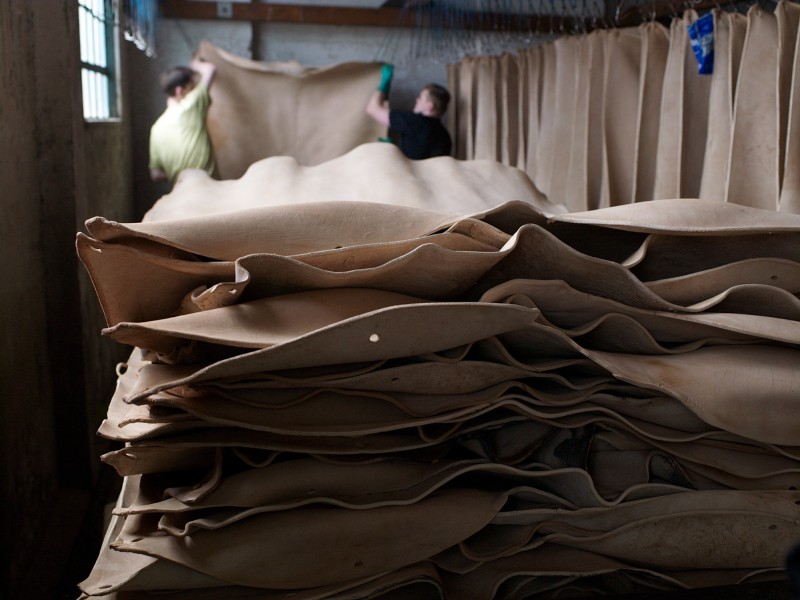
An Intimate Understanding Of Leather
Where is the leather sourced?
Is it genuine unmarked full-grain leather?
Has the correct part of the hide been used?
Has the leather been correctly tanned?
Is it cowhide or oxhide?
Is the leather aniline-dyed right through or plastic surface sprayed?
Can the floors be used above radiant under-floor heating?
The answers to these questions and much more are answered below.
Splits leather
Splits leather is a piece of leather from which the valuable outer layer, the epidermis or skin, has been removed (split) to be sold for top dollar either to upholsterers or other leather product manufacturers. The leftover flesh would normally be treated as a waste product and disposed of, but some of the more unscrupulous manufacturers spray a false skin onto its surface to produce what is called splits leather. If you buy a splits leather floor, you will actually be walking on plastic, not leather. Faux-leather floors, vinyl, linoleum and the like offer a visually similar option and the same surface finish at a far cheaper price.
Corrected leather
Corrected leather is produced when second-rate hides are corrected by sanding the skin down to remove unsightly blemishes and marks. This actually reduces the skin thickness to 0.5mm, thus compromising the resilience of the leather.
The other factor to bear in mind is that by correcting the leather, you remove its signature: the grain. It is this natural grain pattern that signals the difference between real and fake leather.
The ultimate English full-grain leather floor
Full-grain leather is pure untouched, unadulterated leather. Nonetheless, it still comes in different grades. For instance, cattle reared in hot barren pastures enclosed by barbed wire, heavy with insects, will yield scratched, badly blemished and poorly conditioned hides. On the other hand, cattle reared on an insect free south-western English beef farm with an abundance of luscious green grass, benefiting from proper husbandry will produce an entirely different quality of hide. Indeed, it is internationally recognised within the leather trade that the finest full-grain leather hides in the world are to be found in England; the very best are known as ‘Number 1s’. It is exclusively these English Number 1 hides that are used in the production of an Element7 leather floor – with the following additional criteria.
Since leather fibre strength is vital to a floor, at Element7 we insist on oxhides (male) rather than the slightly weaker cowhides (female). Moreover, we will only use the middle-back-butt sections, which is where the leather is at its strongest. We also check that the hide wholesalers who supply our tannery are not sourcing from farms that use steroids in cattle feed. Steroids stress the cattle and make for more prominent veins, in addition the cattle grow too fast therefore producing weaker hides.
The correct way to tan a leather floor
Having selected our hides, we then have them pit vegetable tanned. Pit vegetable tanning is a slow traditional, but natural tanning process, that produces a far superior quality of leather. Today, most leather floors and almost all other leather products are chrome tanned. Though far quicker than pit vegetable tanning – 24 hours as opposed to eight weeks, hence its appeal – chrome tanning is a highly toxic process. The chromium chemicals used actually damage and weaken the leather fibre. This may not be a significant issue for a handbag or a wallet, but it is a major consideration for a leather floor since strength is such a key attribute.
The correct way to dye a leather floor
The final part of the process is to aniline dye the hides getting the colour right through the hide. We do not use instant spray-on pigmented (painted) surface finishes. Pigmented surface finishes look and feel like plastic, do not allow the leather to breathe, when scratched cannot be repaired and, being primarily made up of urethanes, defeat the whole purpose of a leather floor – in fact, they completely conceal the leather so that what you see and walk on no longer actually is leather! Aniline dyeing the hides is once again the older, more traditional approach and takes a long time – days, not minutes, for the dyes to penetrate the hides completely. This method allows you to appreciate the natural beauty of the leather and to enjoy watching it develop its own saddle-worn patina as it matures.
The crucial engineered backing board
Our finished hides are fully bonded to completely stable engineered-wood backing boards. They incorporate the same proven wood engineering technology as our wide-plank floors. The stability provided by this allows our leather floors to deal with radiant under-floor heating, which in effect turns the floor surface into a giant radiator. In addition, the leather is glued and pressed onto the board in a controlled factory environment using pressurised presses (not on site). This means that the leather will never bubble or curl up at the edges.